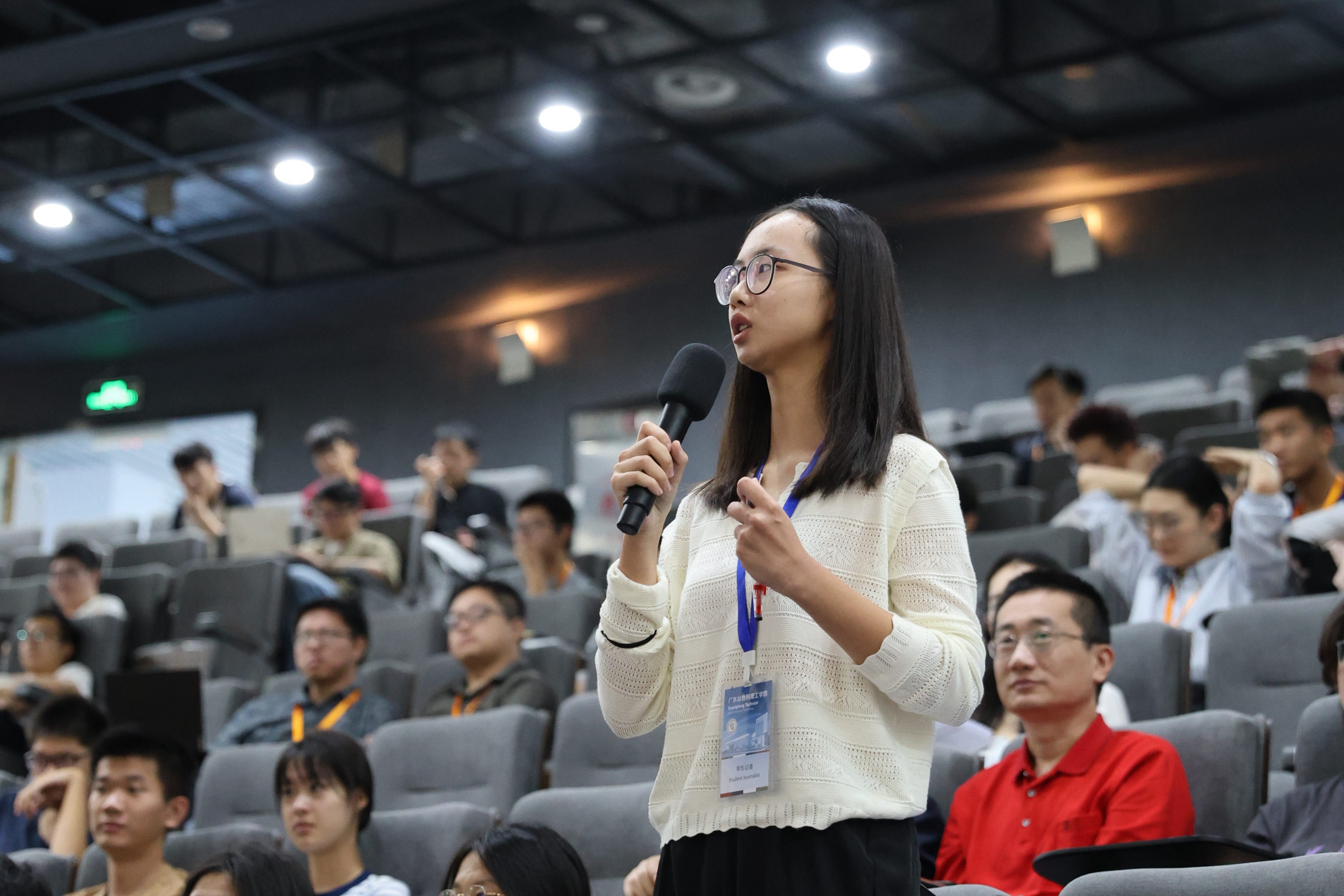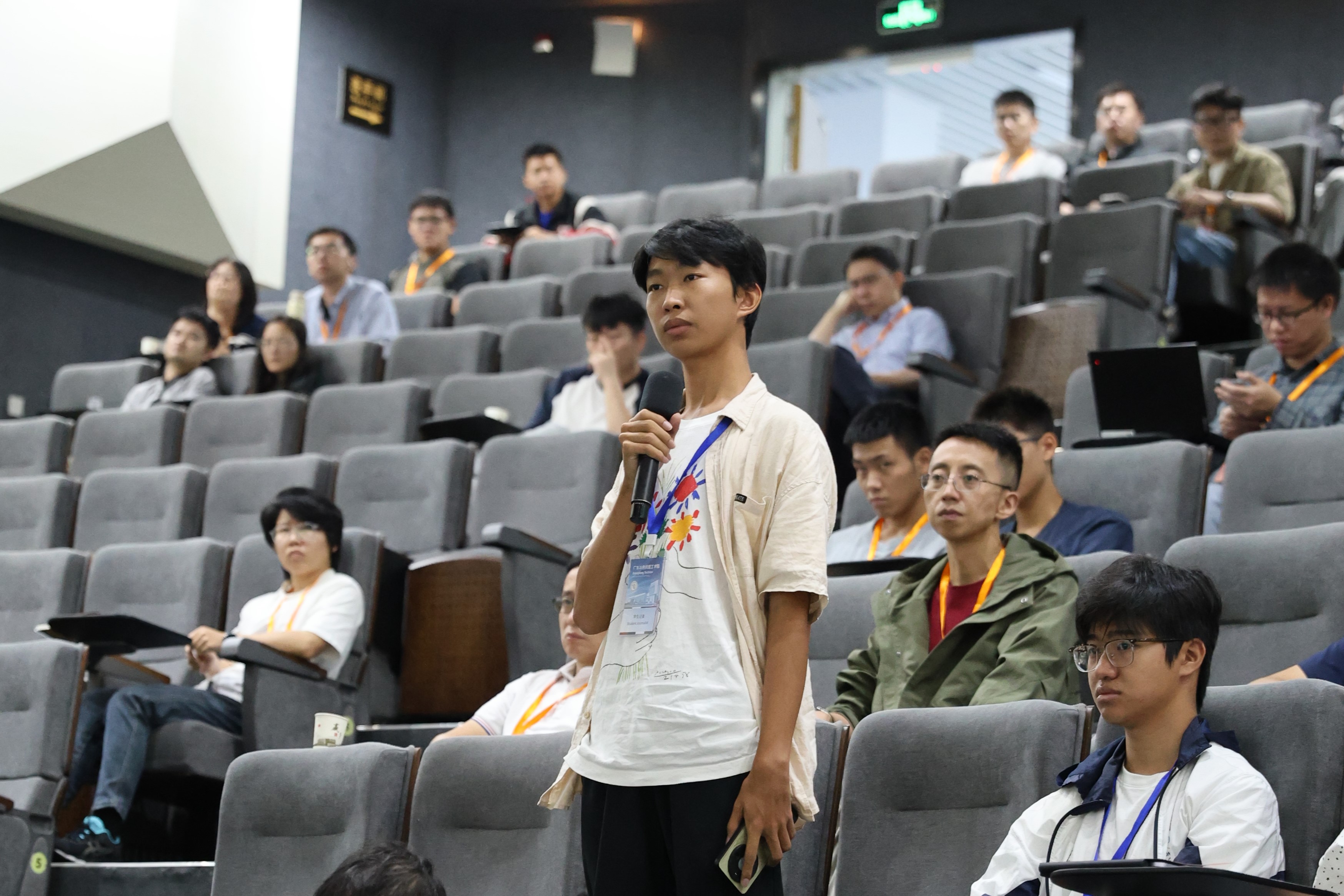PostTime:11/24/2025
Recently, the 2nd Materials Science Summit-Al Materials was held at Guangdong Technion - Israel Institute of Technology (GTIIT). The summit was attended by four Chinese Academy of Sciences (CAS) academicians and gathering nearly 180 top scientists and young students from over 60 universities and enterprises to chart the blueprint for AI-materials innovative integration.
Amidst this scientific feast, student journalists from GTIIT Student Media Center were active both on and off the stage: engaging with scholars through thoughtful questions, capturing highlight moments through their lenses and recording insights with their pens. Let us revisit this enlightening academic journey through their perspectives.
Zhang Letong (BFE Program)
The 2nd MDPI Materials Science Summit was held at GTIIT successfully on November 2. It was a memorable day. Not only was it my first practical opportunity to embrace the new identity of a "journalist", but it also gave me the chance to engage in "brainstorming" with the experts from all fields of sciences, which was extremely beneficial to me.
This summit mainly focused on the integration of AI and materials science, deeply exploring the convenience brought by AI to material selection and application, greatly simplifying the complex and cumbersome process of finding suitable materials. Among the topics presented at the conference, the one that impressed me the most was the research on AI-enabled amorphous materials by Academician Wang Weihua from the Institute of Physics, Chinese Academy of Sciences. At the beginning, he generally expounded on the two major difficulties in material research before the rise of AI: the curse of dimensionality and the uncertainty of material performance caused by the composition and multi-dimensional structure of materials. This led to the use of inefficient and costly traditional trial-and-error methods to test the applicability of materials. However, after the rise of AI, by connecting our needs with the database, the hidden simple rules in materials (often overlooked in research) can be discovered, thereby transforming the complex relationship between material composition, process and performance into a linear relationship. In this way, not only is the sample space greatly reduced, but it also helps researchers discover the hidden high-dimensional rules of materials.
After carefully listening to Prof. Wang's lecture, I had great expectations and aspirations for the huge potential that AI has shown in the field of materials. However, I still had doubts about whether AI could precisely identify the 10 to the power of 30th (which is an extremely large number) types of materials known in the world to a specific type. Therefore, during the Q&A session, I raised my hand to ask him this question. He patiently explained to me: "AI can greatly simplify the arduous process of discovering target materials for us, but it cannot completely replace the material experiments after narrowing down the range. We are using AI, not being replaced by AI."
The other lectures were also extremely impressive, allowing us to see the vigorous development of AI in various fields and the strong benefits it brings to future technology. Since I am a student majoring in biology, after researching the applications of AI and flexible sensors, I was amazed to discover that these flexible sensors not only can detect human health and avoid the discomfort of wearing electronic devices like health watches, but can also be applied to artificial skin! So perhaps one day in the future, when you are sweating on the playground, a health sensor hidden in your skin is constantly monitoring your heart rate and breathing at all times. What an amazing thing!
As a student journalist, interacting with the academicians and professors broadened my horizons, enriched my knowledge reserves, and also made me more confident in communication, allowing me to express my own opinions. I am extremely honored to participate in this summit, listening to the broad prospects of AI in materials and various fields. This has also made me more convinced that perhaps in the not-too-distant future, some of our imaginative ideas, with the help of AI, can become reality.

photo by Peng Zi'ang
Zhang Kehan (BFE Program)
This summit provided me with the opportunity to interact closely with academicians and professors, listen to reports on the theme of "AI-Enabled Materials R&D", learn about current academic research directions, and gain new insights into both material science and AI.
In recent years, AI has experienced explosive growth, evolving from "artificial stupidity" into a genuine "artificial intelligence" capable of solving diverse problems. It has permeated all aspects of daily life and even begun to take a role in academic research. It is widely recognized that AI can utilize deep learning to build large models, perform high-precision calculations and predictions, and significantly save human and material resources. In designing new materials and predicting unknown structures, AI has demonstrated remarkable performance.
"They can try using AI. AI is a very useful tool and could perhaps be a new direction." When asking Academician Jia Jinfeng the question "If undergraduate students want to undertake a research project on their own, what do you think they could start with?", he gave me this answer without hesitation. In the academician forum, the CAS Academicians expressed positive attitudes towards AI, encouraging everyone to learn and apply it more. Perhaps AI will, like the internet, soon become an indispensable new trend.
What impressed me the most was the approachability of the professors and the rich academic atmosphere. Participating in this conference reinforced my belief in the importance of frequently engaging with cutting-edge research. Firstly, it broadens one's experience and aids personal research; secondly, it helps understand current academic trends, such as the full utilization of AI. However, due to time constraints, and I personally missed the chance to ask questions, there is not enough time for interaction. Next time, I must seize or even create opportunities for interaction.
Wang Yichen (BFE Program)
I once thought that academic conferences and interactions with leading figures in the field were beyond the reach of an undergraduate student. This perception was completely overturned when I had the opportunity to participate in the MDPI Materials Science Summit at GTIIT. During the event, I engaged in face-to-face conversations with pioneers at the forefront of materials science and was pleasantly surprised to find how willing they were to share their insights and answer questions from undergraduate students.
At the summit, I had the honor of speaking with Academician Jia Jinfeng. When asked about what left the deepest impression on him during the conference, he highlighted the widespread integration of artificial intelligence across multiple disciplines and its practical applications in daily life. "It is not only injecting new momentum into materials science research but is also tangibly advancing the development of many other fields. Taking materials science as an example, the integration of AI has significantly accelerated the R&D efficiency of new materials. In the near future, we will see more novel materials being widely applied across various aspects of everyday life."
I also asked Prof. Shen Jian the question "What opportunities and challenges does intelligent computing based on spin systems—a highly efficient computational method—face in practical applications?", he told me that "The main challenge lies in achieving generalizability. We usually expect a computing hardware platform to handle diverse tasks flexibly, but for most of the functional systems we've worked with so far, achieving broad applicability with a single hardware platform remains quite difficult. However, we can turn this into a strength by identifying different physical systems that are particularly suited to specific types of tasks—for example, some systems excel at associative memory, while others are better at image processing. This approach can help us build dedicated systems that are structurally simple, fast, and energy-efficient for specific applications. Our achieved results show that spin systems are capable of nanosecond-level ultra-fast image processing, far exceeding the speed of existing chips and software. Currently, we are moving forward with a more ambitious plan: to develop a new type of chip based on a novel physical architecture, with performance surpassing that of GPUs. If successful, we expect it to have a profound impact in related fields."
Through in-depth discussions, I gained a deeper understanding of the interdisciplinary trends in materials science and AI, as well as advanced technologies like intelligent computing in spin systems. This experience ignited a profound sense of aspiration and enthusiasm for materials science within me. It made me realize that top-tier academia has no boundaries—as long as one carries passion, young students can also engage with cutting-edge research and follow the light of knowledge.

photo by Peng Zi'ang
Liu Jiayi (CE Program)
I was deeply impressed by how AI empowers material science development. On the one hand, AI accelerates material discovery efficiency. Traditional material research relies on the "trial-and-error method"—for instance, developing new battery materials from theoretical prediction to experimental validation can take years. In contrast, AI can screen millions of compounds at once, increasing new material discovery efficiency while reducing costs. On the other hand, AI helps build databases, enabling convenient and efficient support for the advancement of new materials.
After listening to Prof. Zheng Qingbin's report, I became curious about the potential applications of such sensors on campus. I boldly posed this question to him, and he patiently replied, "The most immediate use would be health monitoring during gaming. Some highly sensitive sensors can detect pulse and other signals—for example, when attached to the wrist. These sensors are highly flexible, stretchable, and low-modulus elastomers, feeling like a second skin for seamless, unnoticeable health tracking. Traditional materials like metals cannot conform to the skin effectively. Additionally, these new sensors are extremely low-cost, with a core of carbon-based material graphene oxide, making large-scale application feasible."

Engaging with experts and scholars broadened my knowledge and horizons significantly. Face-to-face discussions allowed me to deeply understand how new materials apply to real life, expanded my perspectives, and taught me professional thinking patterns and research methods. All research stems from needs; we must learn to identify daily-life demands and leverage AI to make life more convenient. Furthermore, these interactions boosted my motivation and confidence in learning. In the future, I hope to apply AI to advance the chemical engineering industry.
This summit interview made me realize that as a student journalist, I need to enhance my on-the-spot adaptability. For example, due to time constraints, the questions session after scholars' reports was canceled. Fortunately, I seized the moment to interview Professor Zheng immediately after his presentation. This event also shattered my traditional perception of journalism. While we may lack professional knowledge in materials or interview, we excel with the enthusiasm of "fearless newcomers" and unique student perspectives—though not mature enough, we can still reach for the heights of technology. In the future, I will keep my passion for expression and participate in more activities.
Text/Photos: GTIIT News & Public Affairs, GTIIT Student Media Center
© GUANGDONG TECHNION-ISRAEL INSTITUTE OF TECHNOLOGY | 粤ICP备17036470号
